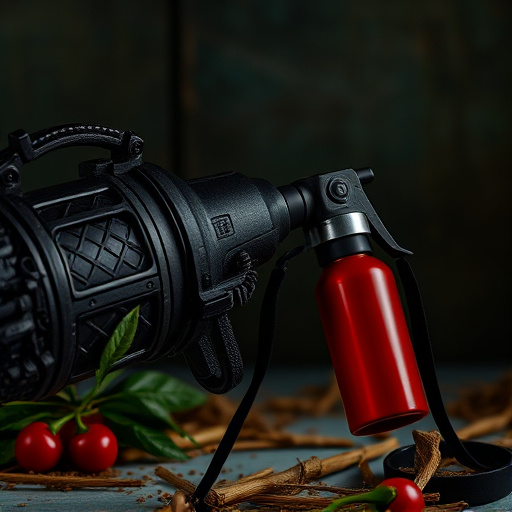Tactical pepper spray, using oleoresin capsicum (OC) as its active ingredient, is a civilian protection tool with various deployment methods. Handheld canisters, clip-on devices, and integrated personal defense systems offer accessibility for everyday carry or law enforcement. Effective deployment techniques include aiming for sensitive areas like eyes, nose, and mouth; practicing under conditions mimicking real-world scenarios; understanding optimal range (2-3 meters) and wind dynamics; and combining methods with situational awareness. Legal considerations and safety precautions, including regional regulations, protective gear, and regular maintenance, are paramount for responsible use.
In today’s unpredictable world, civilians increasingly seek personal defense options. Tactical pepper spray stands out as a powerful yet non-lethal tool for self-protection. This article delves into the fundamentals of tactical pepper spray deployment methods, offering insights on effective techniques tailored for civilian use. From understanding the basics to navigating legal considerations and safety precautions, we equip readers with knowledge crucial for making informed decisions about personal security.
- Understanding Tactical Pepper Spray Basics
- Effective Deployment Techniques for Civilians
- Legal Considerations and Safety Precautions
Understanding Tactical Pepper Spray Basics
Tactical pepper spray, also known as oleoresin capsicum (OC) spray, is a powerful tool for civilian protection. Understanding its basics involves grasping the deployment methods and the science behind its effectiveness. The most common tactical pepper spray deployment methods include handheld canisters, clip-on devices, and personal defense devices integrated into clothing or accessories. Handheld canisters are popular due to their convenience and ease of use; they emit a stream or spray that covers a targeted area, temporarily incapacitating the assailant by irritating the eyes, nose, and respiratory tract.
Clip-on devices and integrated personal defense systems offer advantages in terms of accessibility and discreetness. These methods allow users to have pepper spray readily available without bulk, making them ideal for everyday carry or law enforcement operations. The key to tactical pepper spray’s effectiveness lies in its active ingredient, capsaicin, which is derived from chili peppers. When deployed, capsaicin causes a burning sensation and inflammation, leading to temporary blindness, coughing, and difficulty breathing. This rapid response gives users precious time to escape dangerous situations.
Effective Deployment Techniques for Civilians
For civilians considering tactical pepper spray as a protective measure, understanding effective deployment techniques is paramount. Unlike law enforcement officers who receive extensive training in various self-defense tactics, civilians must adapt their approach to suit practical, everyday scenarios. The key lies in learning quick and reliable deployment methods that minimize surprise and maximize impact. One popular technique involves the use of a speed-based strategy, where individuals aim for the eyes, nose, and mouth—areas most sensitive to capsaicin, the active ingredient in pepper spray. Practicing this method under different conditions, such as wearing glasses or masks, can significantly enhance its effectiveness.
Additionally, understanding range and wind dynamics is crucial. Pepper spray is most effective at close range, typically up to 2-3 meters, so civilians should aim to get within this distance of an attacker before deploying the spray. Wind direction also plays a vital role; deployment against the wind ensures that the spray moves towards the target, increasing its chances of causing disorientation and temporary blindness. By combining these tactical pepper spray deployment methods with situational awareness and quick reflexes, civilians can effectively deter potential threats and gain valuable time to escape potentially dangerous situations.
Legal Considerations and Safety Precautions
When considering tactical pepper spray for civilian protection, it’s crucial to understand the legal considerations and safety precautions involved. Each jurisdiction has specific laws regarding the possession, use, and deployment methods of defensive spray. It’s essential to research and comply with local regulations to avoid legal repercussions. Knowing when and how to deploy pepper spray is critical; misuse can lead to severe consequences for both the user and bystanders.
Safety precautions should always be prioritized. Users must receive proper training on tactical pepper spray deployment methods to ensure effective and safe use. This includes understanding the range, wind conditions, and potential for cross-contamination. Wearing protective gear, such as gloves and eye protection, can also mitigate risks. Regular maintenance of the spray device is vital to guarantee its reliability in high-stress situations.
Tactical pepper spray, when used responsibly and according to legal guidelines, can be a powerful tool for civilian self-defense. By understanding the basics of its deployment, practicing effective techniques, and being aware of legal considerations, individuals can enhance their personal safety in various situations. Utilizing appropriate safety precautions ensures that pepper spray remains a valuable asset for protecting oneself and one’s loved ones without causing harm to others. Remember, proper training and knowledge are key to effective deployment methods, making tactical pepper spray a practical solution for civilian protection.
